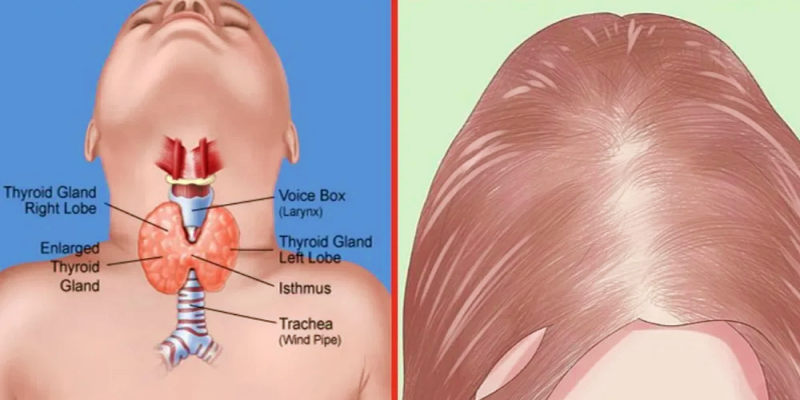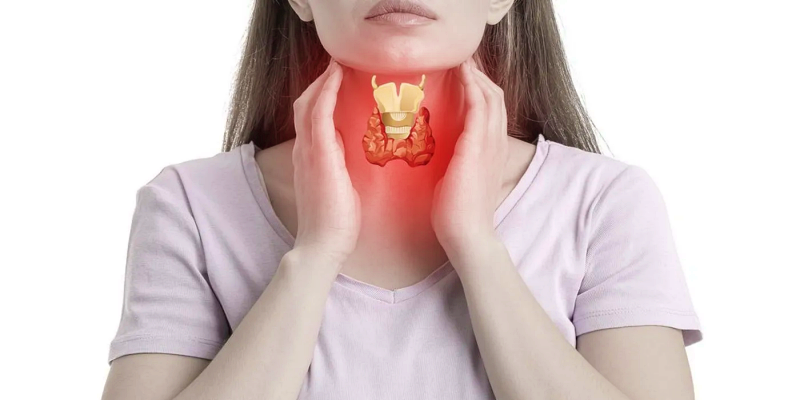Thyroid Diseases and the Risk of Hair Loss

1
One of the most important diseases that carry behind it many negative consequences and many health problems, we must mention thyroid diseases. If the disease is in its advanced stages, it is possible that this will result in a case of hair loss in different parts of the patient’s body. From here, we decided to open the file of thyroid diseases and the risks of hair loss in an explanatory and interpretive manner to work on understanding this disease in a sound and healthy way.
Thyroid disease and hair loss


Thyroid disease and hair loss
When talking about the problem of hair loss, it should be known that it is one of the most important problems resulting from autoimmune diseases common with thyroid diseases, which lead to incomplete hair loss, especially in the most distinctive areas. Over time, it can directly cause baldness.
More specifically, when hormone production is disrupted due to thyroid problems, especially T3 and T4 hormones, this can affect other processes in the body, including hair growth at the root, where hair loss occurs and may not be replaced by new growth, which leads to hair loss and thinning of the scalp and other areas such as the eyebrows.
It is also worth noting that other autoimmune diseases can lead to hair loss and are often associated with thyroid problems, such as polycystic ovary syndrome and lupus erythematosus.
Thyroid diseases that cause hair loss


Thyroid diseases that cause hair loss
-
Hypothyroidism
Patients with hypothyroidism complain of hair loss, dryness and extreme weakness, because when the thyroid function is disturbed, thyroid hormones are not fully produced, which slows down the body’s metabolism and resistance.
-
hyperthyroidism
When suffering from this disease occurs, the production of thyroid hormones will exceed the body’s natural needs, which leads to increased metabolism and increased cell activity, including hair germ cells.
It is also worth noting that an excessive metabolic rate causes the body to consume energy quickly, which reduces the flow of blood and nutrients that nourish the hair, and leads to hair weakness and hair loss.
-
Thyroid cancer
Thyroid cancer can also cause hair loss or changes in hair texture, such as dry, thin, and brittle hair.
Read also: Hair loss due to weight loss and ways to overcome it
Signs of hair loss associated with the thyroid gland


Signs of hair loss associated with the thyroid gland
This disease appears clearly through some symptoms represented by the thinness and weakness of the affected person’s hair, as he loses between 50 and 100 hairs from the head daily, and the normal growth of hair is disrupted, and its strands are not renewed, and a state of recurrent pathological hair loss may occur.
It should also be noted that thyroid diseases do not only cause hair loss, but this may also directly affect the hair texture and many other hair areas in the body, where some of the following signs appear:
- Hair loss may occur in patches, areas, or all over the scalp.
- Weakness and dryness due to loss of its natural moisture.
- Hair loss and slow growth of new hair.
- New hair growth is thin and weak.
- Eyelashes and eyebrows appear thin and weak.
In addition, thyroid diseases are accompanied by many other symptoms such as irregular heartbeat, fatigue and stress, noticeable changes in weight, difficulty sleeping, suffering from depression, digestive disorders…etc.
Treatment of hair loss caused by thyroid diseases


Treatment of hair loss caused by thyroid diseases
First of all, we can say that mild thyroid diseases usually do not cause hair thinning, weakness and loss. Therefore, if treated properly, it is possible to avoid and overcome this pathological condition.
For clarification, the doctor may prescribe some therapeutic medications, such as the following:
- Levothyroxine (hypothyroidism)
- Propylthiouracil and methimazole (hyperthyroidism)
- Beta blockers (hyperthyroidism).
With severe cases receiving treatment, hair growth may be observed within a few months. It should be noted that newly transplanted hair may differ in color or texture from the original hair.
Home remedies for hair loss caused by thyroid disease


Home remedies for hair loss caused by thyroid disease
In addition to the pharmaceutical products that are prescribed by doctors, there are also many home remedies that you can try to slow down hair loss or renew its growth. It is worth noting that these treatments are as follows:
– Boosting iron in the body, as low ferritin can increase the risk of hair loss, and thus iron supplements help boost this ferritin.
Treating signs of malnutrition by eating foods rich in calcium and using levothyroxine to obtain the best absorption.
– Change your hair styling routine by gently combing your hair, reducing the use of heat styling tools such as hair dryers and straighteners, and completely avoiding chemical dyes, etc.
– Build a balanced diet of vitamins and minerals by eating foods that contain vitamin A, B vitamins, vitamins C and E, zinc, calcium, and others, in order to support the nutrition of hair germ cells.
– Work on supplementing the iodine element in a balanced way, because a deficiency or excess of this element increases the risk of suffering from thyroid diseases. Therefore, patients must be evaluated for iodine deficiency and comply with the doctor’s instructions as much as possible in this regard.




